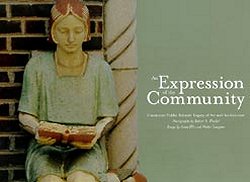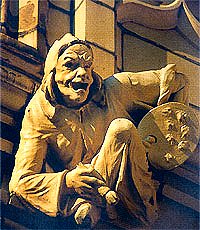Monday, March 07, 2005
Uplifting Beauty

A beautiful book, An Expression of Community, produced by Cincinnati, Ohio’s Art League provides a photographic record of the archaic American belief, adapted from the philosophy of John Ruskin and modified by the late 19th century Arts and Crafts movement, that “beauty uplifts the spirit, inspires the soul and transforms character” and “where better to showcase inspiring works of beauty than in public schools?”
This spectacular and very well made book, a must for any American Art Pottery collector, contains many gorgeous and never before seen images of Rookwood and Wheatley tile installations and is available through Barnes & Noble as well as through the Art League and the American Art Pottery Association.
In addition to architectural ceramics, the book’s color plates also record the breath-taking array of painted murals, sculpture, stained glass and other architectural embellishments that once enhanced Cincinnati’s older public schools.
While, sadly, some of these historic and quite valuable pieces have been destroyed or stolen, the Art League is in the process of preserving many of these public treasures and moving some of them into the newly constructed generation of Cincinnati Public Schools.

Portion of a Rookwood tle panel from the former Madisonville Elementary
As a baby-booming resident of the expanding ring of newer metropolitan Cincinnati area suburbs, I was schooled amid stark, artless modernity.
The drinking fountains of my atomic age generation were cold stainless steel rather than pictorial ceramic.
Our schools windows were clear glass, adorned only with gray Venetian blinds.
Our 1960’s and 70’s classroom corridors were only lined with a modern-life-dooming troika of lockers, trophy cases and fossilized images of long-past graduating classes and dour former school administrators.
Indeed, as time passed and school buildings became more crowded, teachers were even denied the ability to decorate their particular teaching environment as they joined the rootless mass trooping from one barren modular classroom to another.
It is brutally clear from the Art League’s documentation of early 20th century Cincinnati public schools that modernity’s industrial triumph hasn’t merely streamlined today’s schools but, rather, has limited the breadth of our collective national soul and hardened our modern hearts.

Glazed terra cotta grotesque on exterior of the old Hughes High School
Beauty, be it nature or the artistic gift of man’s hand, does, merely by proximity, uplift, soften and illuminate mankind’s spirit.
It is unique, sometimes without price and sometimes extraordinarily dear.
And, tragically for our children and ourselves, beauty is increasingly something we only rarely witness in museums, theme parks or on special interest cable channels and almost never witness in the cold reality of our daily lives.
Ruskin and the adherents of the Arts and Crafts movement lost the last century’s battle with their industrial foe and we post modern humans, speeding along superhighways in fossil-fuel guzzling and often satellite-tracked behemoths, are still self-destructively addicted to the shiny mechanical fruit falling from the unforgiving and robotic Tree of Knowledge.
Modern technology and science are great gifts made more special and appealing when balanced with the products of the brain’s opposite hemisphere.
As we struggle through the early war-torn years of this new millennium, it seems clear that if our Western Civilization is to survive the internal and external barbarian hordes of anti-intellectualism our own internal battles between art and science must modify from a victory-beset war metaphor to that of a winless dance.
Groups of interested citizens like Cincinnati’s revived Art League are a tremendous step toward a future that glorifies and uplifts mankind.
But, ordinary citizens, while vital, are not the only key.
As with the recent potential legal entanglements for remuneration-free web publishing, leaders from art, science and industry must, as did certain great minds of the 19th century, wean themselves from the winner-take-all mindset and shave off a portion of their God-given brilliance for the artistic uplift of modern man and, of course, the common good.
It would be, after all, to their benefit, and likely profit, as well.
Images: AAPA, Robert A. Flischel

